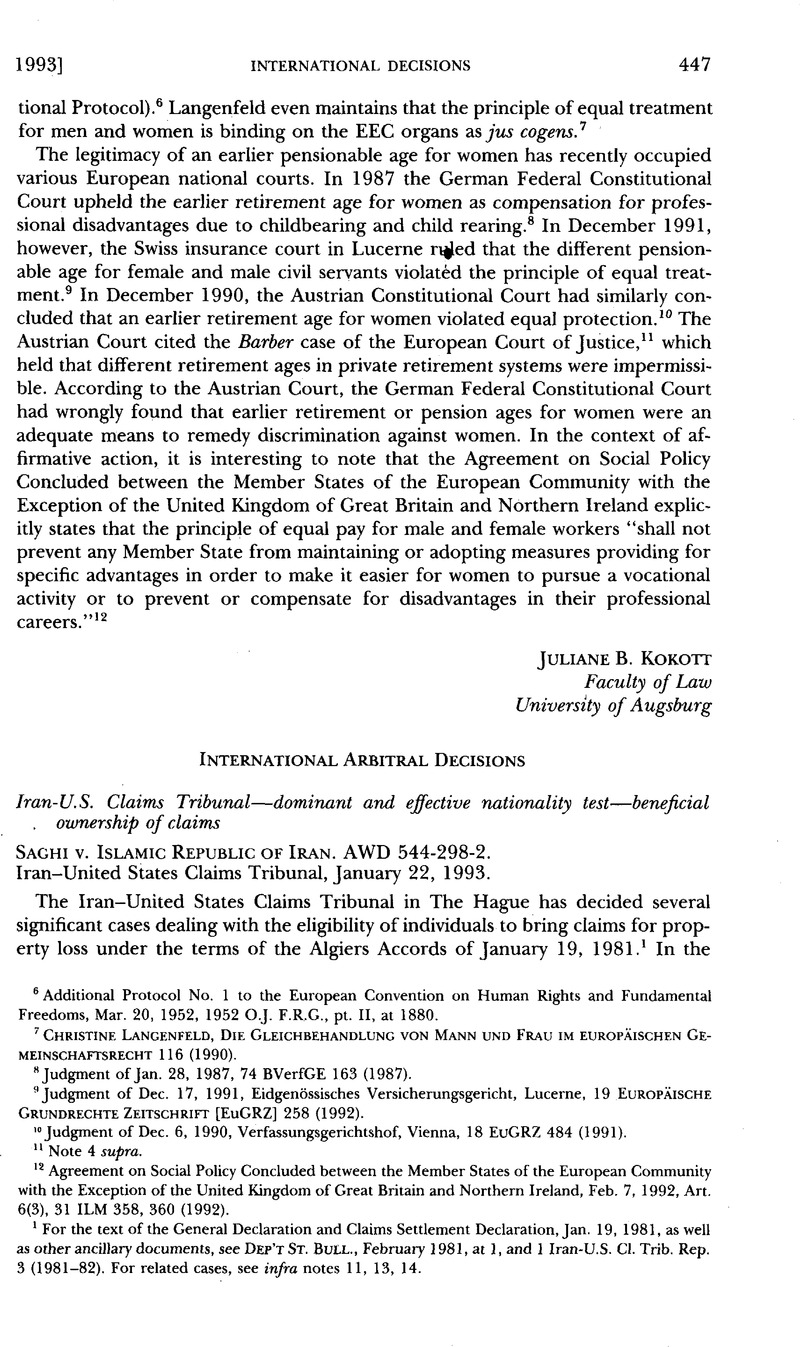No CrossRef data available.
Published online by Cambridge University Press: 27 February 2017

1 For the text of the General Declaration and Claims Settlement Declaration, Jan. 19, 1981, as well as other ancillary documents, see Dep’t St. Bull., February 1981, at 1, and 1 Iran-U.S. Cl. Trib. Rep. 3 (1981–82). For related cases, see infra notes 11, 13, 14.
2 Islamic Republic of Iran v. United States (Case A/18) (Dual Nationality), 5 Iran-U.S. Cl. Trib. Rep. 251 (1984), summarized in 78 AJIL 912 (1984) [hereinafter A/18 Decision].
3 See id. at 265–66.
4 Id.
5 See id. at 265.
6 AWD 544-298-2 [hereinafter Saghi]. As of press time, the dissent in Saghi of the Iranian arbitrator in Chamber Two, Koorosh H. Ameli, was unavailable.
7 See Saghi v. Islamic Republic of Iran, 14 Iran-U.S. Cl. Trib. Rep. 3 (1987).
8 A/18 Decision, supra note 2, Concurring Opinion of Richard M. Mosk, 5 Iran-U.S. Cl. Trib. Rep. at 272 (citing Flegenheimer Case (U.S. v. It.), 14 R.I.A.A. 327, 398 (1958)).
9 Id. at 273.
10 A/18 Decision, supra note 2, Concurring Opinion of Willem Riphagen, 5 Iran-U.S. Cl. Trib. Rep. at 274.
11 Esphahanian v. Bank Tejarat, 2 Iran-U.S. Cl. Trib. Rep. 157, 166 (1983), summarized in 77 AJIL 646 (1983).
12 Id. at 167.
13 See Golpira v. Islamic Republic of Iran, 2 Iran-U.S. Cl. Trib. Rep. 171, 173–74 (1983).
14 Mahmoud v. Islamic Republic of Iran, 9 Iran-U.S. Cl. Trib. Rep. 350, 354 (1985).
15 See, e.g., Civ. C. Art. 988 (Iran) (requiring individuals who renounce Iranian nationality to undertake “to transfer, by some means or other, to Iranian nationals, within one year of the date of the renunciation, all rights that they possess on landed properties in Iran or which they may acquire by inheritance”).
There is some question whether Article 988 actually serves to divest non-nationals of real property in Iran, or whether it simply enables the Government (through the Public Prosecutor) to seek possession. Article 989 makes clear, however, that compensation is due in such circumstances. Finally, one may wonder whether these provisions can even apply to a dual national.
Some cases have mentioned employment restrictions based on Iranian nationality. See Monemi v. Islamic Republic of Iran, AWD 533-274-1, para. 28 (July 1, 1992) (Chamber One) (although there was no indication that the claimant sought an award for lost salary in such a job); Malekzadeh v. Islamic Republic of Iran, AWD 543-356-1, para. 26 (Jan. 22, 1993) (Chamber One).
16 Schott v. Islamic Republic of Iran, 24 Iran-U.S. Cl. Trib. Rep. 203, 218 (1990).
17 Id. at 218.
18 Treaty of Amity, Economic Relations, and Consular Rights, Aug. 15, 1955, U.S.-Iran, 8 UST 899, 284 UNTS 93. The Treaty of Amity was held to be applicable between the two countries even during the revolution. See United States Diplomatic and Consular Staff in Tehran (U.S. v. Iran), 1980 ICJ Rep. 3, 28 (May 24).
19 See Saghi, para. 59.
20 See id., paras. 36, 56 (quoting applicable provision of Iranian “Law for Expansion”).
21 Id., para. 59.
22 Id., para. 60.
23 Saghi, Concurring Opinion of George H. Aldrich, para. 3.
24 See Saghi, paras. 60–64.
25 Concurring Opinion of Willem Riphagen, supra note 10, at 274.
26 Saghi, para. 59.
27 See id., para. 58; and Concurring Opinion of George H. Aldrich, supra note 23, para. 2.
28 Saghi, para. 53 (emphasis in original) (quoting Khosrowshahi v. Islamic Republic of Iran, 24 Iran-U.S. Cl. Trib. Rep. 40, 45 (1990); Protiva v. Islamic Republic of Iran, 23 Iran-U.S. Cl. Trib. Rep. 259, 263 (1989)).
29 Id., para. 54.
30 See id., paras. 61, 63.
31 See id., para. 28.
32 See id., paras. 18–23 (discussing, inter alia, Foremost Tehran, Inc. v. Islamic Republic of Iran, 10 Iran-U.S. Cl. Trib. Rep. 228 (1986); International Technical Prods. Corp. v. Islamic Republic of Iran, 9 Iran-U.S. Cl. Trib. Rep. 206 (1985); and Isaiah v. Bank Mellat, 2 Iran-U.S. Cl. Trib. Rep. 232 (1983)).
33 See id., para. 24 (citing Claims Settlement Declaration, supra note 1, Art. 7, para. 2, for requirement of continuous ownership of claims by individuals of eligible nationality).
34 Id.
35 Id., para. 26.
36 See id., para. 25 (quoting Article 10 of the Iranian Commercial Code).
37 Id. (quoting Claims Settlement Declaration, supra note 1, Art. 2, para. 1).
38 For a collection of materials, see David J. Bederman, Beneficial Ownership of International Claims, 38 Int’l & Comp. L.Q. 935 (1989).
* The writer was a Legal Assistant at the Iran-U.S. Claims Tribunal in 1988 and 1989. The views expressed here are his own.